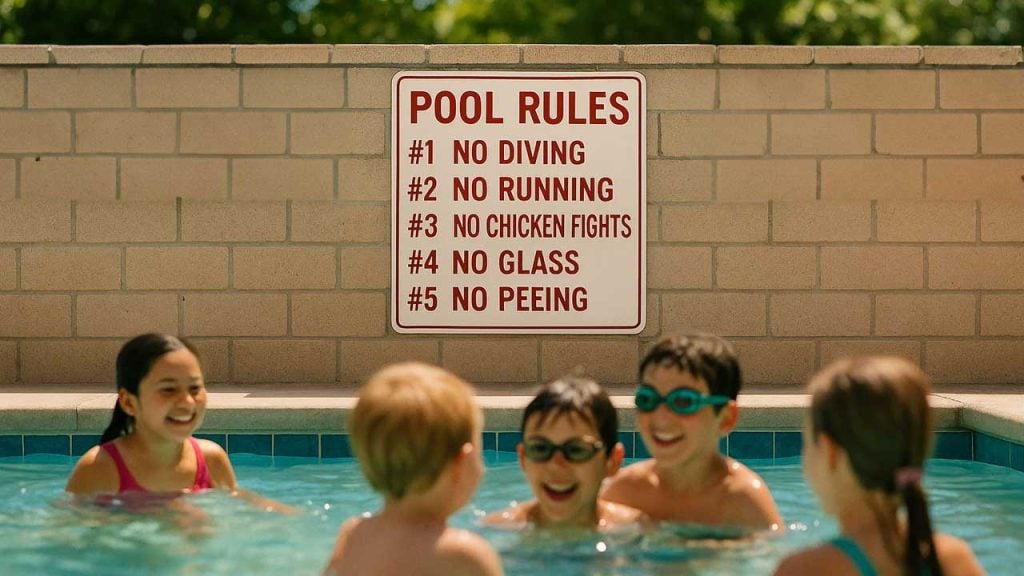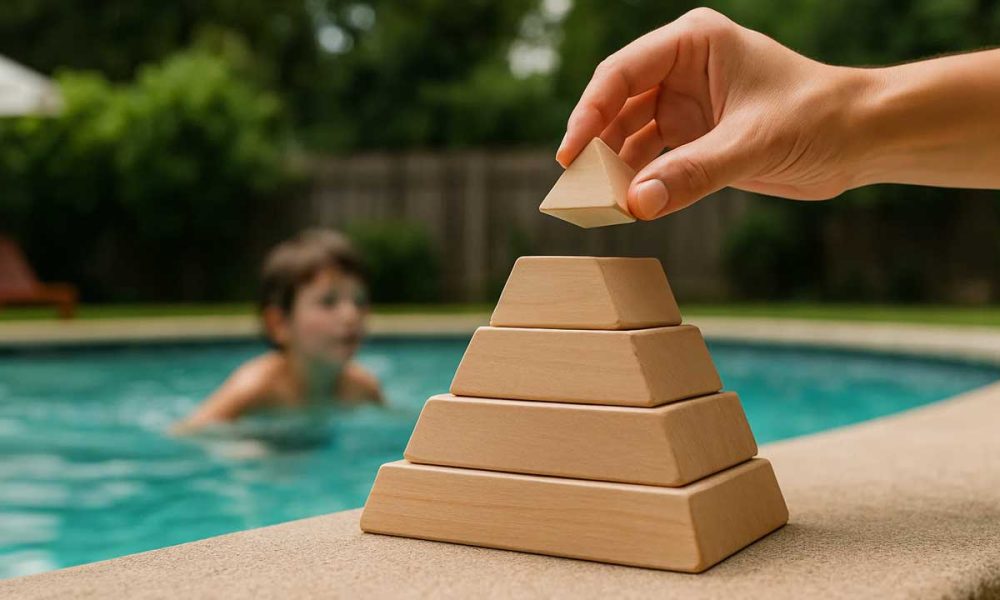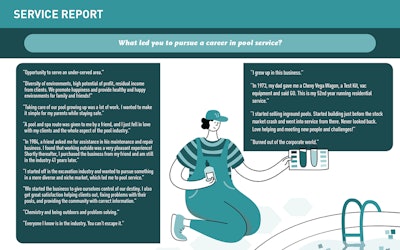Drowning remains the leading cause of accidental death for children ages one to four in the United States—a tragic reality that is often preventable. As May marks National Water Safety Month, there’s no better time to spotlight the steps parents, guardians, and pool owners can take to protect children during swim season. Dr. Adam Katchmarchi, a nationally recognized expert in drowning prevention and water safety, joined Pool Magazine Podcast to offer practical, potentially life-saving advice.
Why Pool Safety Month Matters
“May is really the kickoff to the summer swim season,” said Katchmarchi. “It’s when many backyard pools start opening, and public recreation facilities and waterparks begin operations. It’s the perfect time to remind families to put water safety front and center.”
The idea isn’t to overcomplicate things. In fact, Katchmarchi emphasized that most drowning prevention measures are simple and actionable. “This isn’t complicated information. These are easy steps people can take to keep their families safer.”
Understanding When and Where Drowning Happens
One of the most alarming statistics Katchmarchi shared is that 70% of toddler drownings happen during non-swim times. “We tend to think drowning only occurs when kids are in the water with us,” he explained. “But for young children, it often happens when they wander off and find a water feature unsupervised.”
Whether it’s a backyard pool, decorative pond, or even a creek nearby, unsupervised access to water is a major hazard. That’s why having proper barriers and safety fencing is so critical. “Any water feature is attractive to a curious child. Without barriers, it becomes an invitation to tragedy.”

The Risk of Overconfidence
Even parents of older children need to be cautious. According to Katchmarchi, many parents overestimate their child’s swimming ability. “Research shows parents are not always the best judges of how skilled their child is in the water. That’s why revisiting swim lessons periodically is so important.”
He also cautioned against assuming that swimming skills learned in a backyard pool automatically transfer to natural bodies of water like lakes or rivers. “Currents, cold temperatures, and the absence of quick help in those environments introduce new risks,” he said. “The pool is the best place to build foundational water competency.”
Drowning Can Happen Fast—and Silently
“Most parents expect that their child would call out for help if they were in trouble, but that’s not always the case,” said Katchmarchi. “Drowning is often silent. Children can slip under the water in seconds.”
He emphasized the need for active, focused supervision and debunked the idea that a gathering of adults inherently means someone is watching the pool. “When everyone is watching, no one is watching. That’s why designating a Water Watcher is so effective.”
Organizations like the National Drowning Prevention Alliance and the Pool Safely campaign provide free Water Watcher cards that can be worn as a reminder of responsibility. “That small token can make all the difference.”
Who’s Most at Risk?
Children between ages one and four are at the highest risk of drowning, but Katchmarchi also flagged a sobering reality for children with autism. “Kids with autism are 160 times more likely to drown than their neurotypical peers. Many are drawn to water and prone to elopement.”
The good news? Swim lessons can begin as early as six months of age, and survival skills like back floating and breathing techniques can be taught to toddlers. “We’re not expecting perfect technique,” he said. “We’re teaching them to float, to breathe, to survive.”
The Problem with Assuming Knowing How To Swim is Enough
“Knowing how to swim is one critical layer of protection, but it doesn’t eliminate risk,” said Katchmarchi. He recommends a multi-layered approach that includes supervision, barriers, alarms, water competency, and emergency preparedness.
“We need to think in terms of layers, because supervision can lapse. Even skilled swimmers can panic or become fatigued. It takes a combination of safeguards to create the safest environment possible.”
Safety Starts at Home—Even if You Don’t Have Kids
The rise of pool-sharing platforms means more homeowners are renting out their pools to neighbors and guests. Even if you don’t have children yourself, you still have a responsibility to keep others safe.
“We created a rental safety checklist that applies whether you’re listing on Airbnb or just hosting friends,” said Katchmarchi. “Post your address by the pool, identify your safety equipment, and make sure guests understand your rules.”
He also recommends highlighting any hidden hazards. “Residential pools don’t always have depth markers. Make sure people know how deep the water is. Have a reaching pole or ring buoy and show people how to use them.”

Technology’s Role in Drowning Prevention
“There’s some promising innovation in AI-driven camera systems and smart alarms, but the technology is still evolving,” Katchmarchi noted. “These are high-tech tools, but they’re not a substitute for fences, supervision, and swim skills.”
In commercial settings, AI tools may assist lifeguards in identifying distress, but he warned about relying too heavily on them. “The psychology of lifeguards could change if they feel secondary to a machine. We need to train people to use these systems as supplements, not replacements.”
For residential use, many of these devices serve as smart alarms. “They can notify you that a child has entered the water, but what if you’re not home? These are great enhancements, but they’re just one part of a broader safety net.”
What Every Pool Owner Should Be Doing
One of the most overlooked pool safety risks? Not setting clear rules. “I hate to sound like the party police,” said Katchmarchi, “but people need to communicate what’s okay and what’s not. No breath-holding contests. No diving into shallow water.”
He explained that many backyard pools aren’t deep enough for diving, and even those who know how to dive safely can inadvertently influence others. “You may know how to enter the water, but does your younger cousin? Pool safety isn’t just about your skill—it’s about modeling behavior.”
The Pyramid of Pool Safety
Katchmarchi praised Pool Magazine’s Pyramid of Pool Safety infographic, which outlines layers of protection in a clear and accessible way. “We talk about layers in all types of accident prevention because we can’t rely on just one thing to work every time.”
Pool Magazine’s “Pyramid of Swimming Pool Safety” infographic lays out a tiered approach that highlights the most effective strategies for preventing drowning. Each level builds on the one below it—stacking layers of protection to reduce risk:

- Safety Devices: The foundation of the pyramid includes life-saving tools like life rings, life jackets, reaching poles, drain covers, and alarms. These devices have been statistically shown to help lower drowning fatalities when used properly.
- Fences & Covers: Isolation fencing and safety covers play a huge role in reducing risk. Pools with four-sided isolation fencing and ASTM-certified covers see up to an 83% reduction in childhood drownings compared to pools without these barriers.
- Swim Lessons: Swimming competency is a major safeguard. Participation in swim lessons has been shown to reduce drowning risk by up to 88% among children aged 1 to 4. Teaching floating, safe entry/exit, and survival strokes saves lives.
- Supervision: At the top of the pyramid is vigilant adult supervision—the most important layer. A lapse in supervision is the single leading cause of drowning fatalities among young children in swimming pools. Always designate a responsible Water Watcher and ensure someone nearby knows CPR and basic rescue techniques
The One Thing You Can Do Today
If there’s one takeaway that Katchmarchi urges every parent or pool owner to act on today, it’s this: Get your kids signed up for swim lessons.
“It’s the most effective, proven thing you can do to reduce drowning risk.”
Final Thoughts
National Pool Safety Month is more than a calendar event—it’s a call to action. Whether you’re a parent, grandparent, pool owner, or professional, the steps you take now can save lives later.
“We want families to enjoy their summer and make amazing memories in and around the water,” said Katchmarchi. “But we want those memories to be safe ones.”
For more resources on drowning prevention, including free tools like Water Watcher cards and rental safety checklists, visit organizations like the National Drowning Prevention Alliance, Pool Safely, and the PHTA. In addition, feel free to download our Pyramid of Pool Safety infographic.
Because when it comes to pool safety, a few small changes can make all the difference.
Ready to take a deeper dive?
Listen to our entire conversation with Dr. Adam Katchmarchi on the Pool Magazine Podcast.
The post A Layered Approach That Saves Lives: The Pyramid of Pool Safety appeared first on PoolMagazine.com – Get The Latest Pool News.







